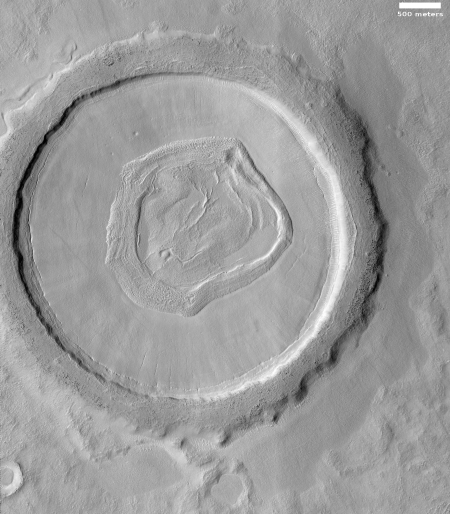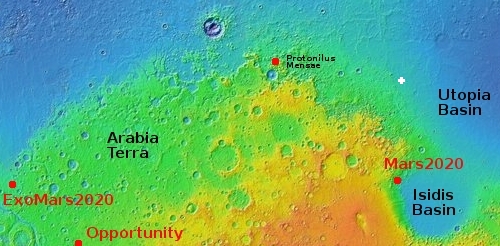Crater in the Martian northern lowlands

Click for original full image.
Cool image time! The photo to the right, rotated, cropped, and reduced to post here, was taken by the high resolution camera on Mars Reconnaissance Orbiter (MRO) on October 26, 2019. It shows a crater in the western edge of Utopia Planitia, the largest and deepest region of the Martian northern lowlands where it is theorized that an intermittent ocean might have once existed.
My first uneducated guess at looking at this image is that the impact occurred in some sort of wet slushy mud or ice, which then melted and filled the crater interior, ponding in the crater’s center as it froze.
A more educated guess, based on what I have learned in the past year, is not much different. The crater is located at 40 degrees north latitude and therefore sits in the middle of the mid-latitude band where scientists think there are a lot of buried inactive glaciers.

The map to the right, revised from my December 20, 2019 post about glaciers flowing off the slopes of a mid-latitude mesa, illustrates this even more clearly.
This crater, indicated by the white cross, sits at approximately the same latitude as that mesa and its glaciers in Protonilus Mensae. It also sits at in an area where accumulated data from several spacecraft have mapped a lot of water ice, close to the surface.
Thus, it is reasonable to suppose that the impact that made this crater pushed into that ice-table, melting the water which subsequently froze and then subsided downward into the ground to form the crater’s central ponded features.
Or to put it as I did initially, the impact smashed into some wet slushy mud/ice, melting it so that it filled the crater interior to then freeze as we see it.
On Christmas Eve 1968 three Americans became the first humans to visit another world. What they did to celebrate was unexpected and profound, and will be remembered throughout all human history. Genesis: the Story of Apollo 8, Robert Zimmerman's classic history of humanity's first journey to another world, tells that story, and it is now available as both an ebook and an audiobook, both with a foreword by Valerie Anders and a new introduction by Robert Zimmerman.
The print edition can be purchased at Amazon or from any other book seller. If you want an autographed copy the price is $60 for the hardback and $45 for the paperback, plus $8 shipping for each. Go here for purchasing details. The ebook is available everywhere for $5.99 (before discount) at amazon, or direct from my ebook publisher, ebookit. If you buy it from ebookit you don't support the big tech companies and the author gets a bigger cut much sooner.
The audiobook is also available at all these vendors, and is also free with a 30-day trial membership to Audible.
"Not simply about one mission, [Genesis] is also the history of America's quest for the moon... Zimmerman has done a masterful job of tying disparate events together into a solid account of one of America's greatest human triumphs."--San Antonio Express-News

Click for original full image.
Cool image time! The photo to the right, rotated, cropped, and reduced to post here, was taken by the high resolution camera on Mars Reconnaissance Orbiter (MRO) on October 26, 2019. It shows a crater in the western edge of Utopia Planitia, the largest and deepest region of the Martian northern lowlands where it is theorized that an intermittent ocean might have once existed.
My first uneducated guess at looking at this image is that the impact occurred in some sort of wet slushy mud or ice, which then melted and filled the crater interior, ponding in the crater’s center as it froze.
A more educated guess, based on what I have learned in the past year, is not much different. The crater is located at 40 degrees north latitude and therefore sits in the middle of the mid-latitude band where scientists think there are a lot of buried inactive glaciers.

The map to the right, revised from my December 20, 2019 post about glaciers flowing off the slopes of a mid-latitude mesa, illustrates this even more clearly.
This crater, indicated by the white cross, sits at approximately the same latitude as that mesa and its glaciers in Protonilus Mensae. It also sits at in an area where accumulated data from several spacecraft have mapped a lot of water ice, close to the surface.
Thus, it is reasonable to suppose that the impact that made this crater pushed into that ice-table, melting the water which subsequently froze and then subsided downward into the ground to form the crater’s central ponded features.
Or to put it as I did initially, the impact smashed into some wet slushy mud/ice, melting it so that it filled the crater interior to then freeze as we see it.
On Christmas Eve 1968 three Americans became the first humans to visit another world. What they did to celebrate was unexpected and profound, and will be remembered throughout all human history. Genesis: the Story of Apollo 8, Robert Zimmerman's classic history of humanity's first journey to another world, tells that story, and it is now available as both an ebook and an audiobook, both with a foreword by Valerie Anders and a new introduction by Robert Zimmerman.
The print edition can be purchased at Amazon or from any other book seller. If you want an autographed copy the price is $60 for the hardback and $45 for the paperback, plus $8 shipping for each. Go here for purchasing details. The ebook is available everywhere for $5.99 (before discount) at amazon, or direct from my ebook publisher, ebookit. If you buy it from ebookit you don't support the big tech companies and the author gets a bigger cut much sooner.
The audiobook is also available at all these vendors, and is also free with a 30-day trial membership to Audible.
"Not simply about one mission, [Genesis] is also the history of America's quest for the moon... Zimmerman has done a masterful job of tying disparate events together into a solid account of one of America's greatest human triumphs."--San Antonio Express-News


Looks like my last latte